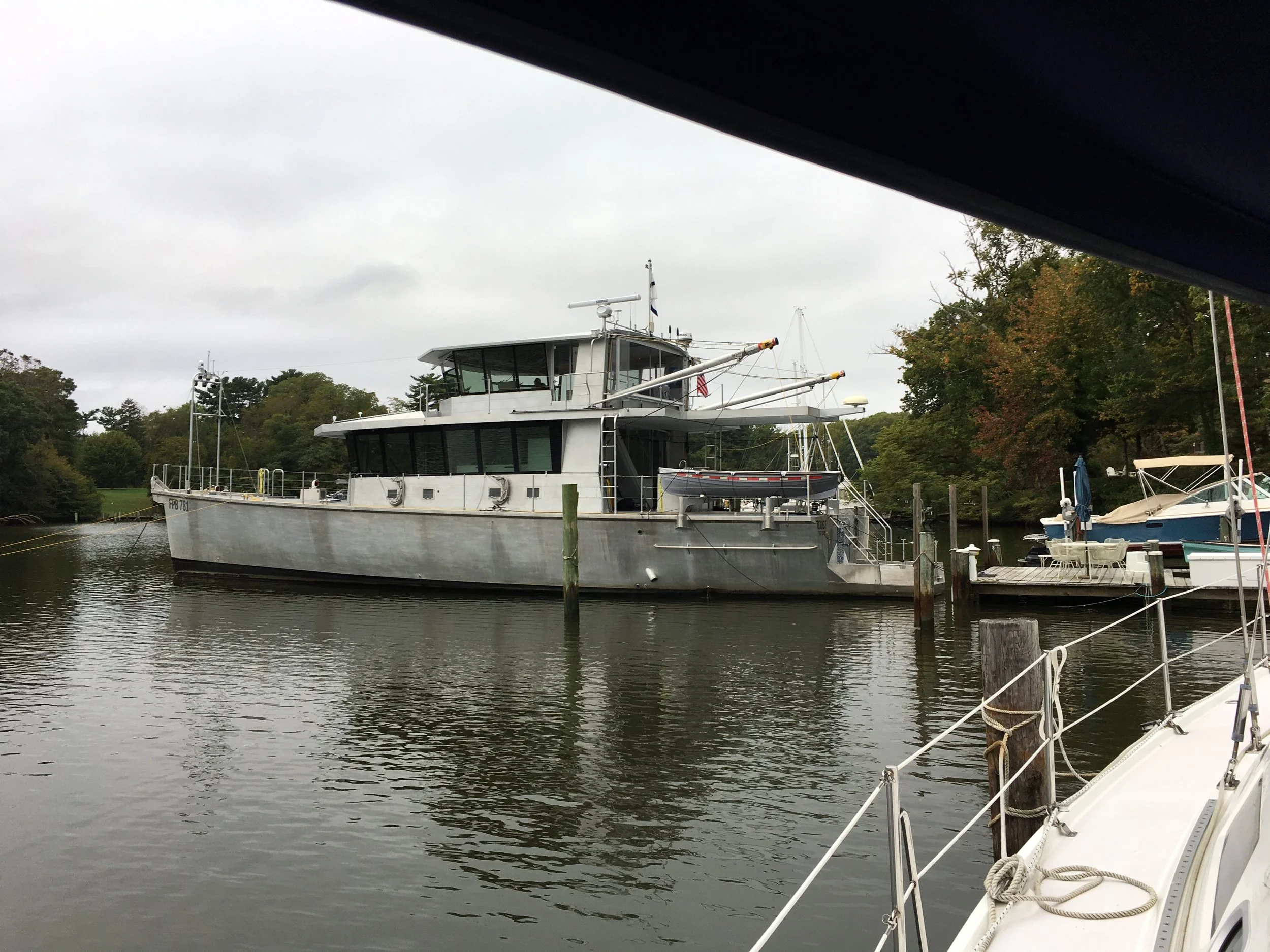As we discussed a couple of weeks ago, Cochise is quite a vessel. I took tons of pictures and Steve Dashew was kind to walk me through the boat and point out the many interesting details that he incorporated into this 78-foot FPB. To review the previous post, take a look at: http://bit.ly/Ultimate_FPB_1.
Here I am going to present the many details that are most interesting. Perhaps they can be of value on your own boat? We will cover some of the engine room details in the next post.
A side Dorade vent pull lots of air into the interior, and the spray hoods keep out the elements. This vent brings air into the starboard side of the saloon, next to the steps between the saloon and the accommodations. See below.
These Victron Energy MultiPlus 24-volt battery charger/inverters are separated and directly beneath the Dorade vent so as to keep cool. Heat kills batteries and chargers lose efficiency as they heat up. They are located behind a door on the steps down into the accommodations and engine room from the saloon. Note the label warning (top left) to shut off the vent before getting under way.
The cradle arms for the RIB swing out to hold the dinghy off the side of the boat, creating a large social area on the aft deck.
Steve demonstrates how easily this stanchion post can be lowered so the RIB can be slid off and launched in an emergency. Cochise does not carry a liferaft, and the RIB and crew immersion suits are the life-saving gear on this boat. That makes so much sense, as operating the RIB is very familiar, everyone uses it on a regular basis, and it can provide an active means of self rescue.
Liferafts are a different story altogether. One never knows if it will even inflate. (Years of doing Safety at Sea seminars confirm that even demo rafts sometimes don't inflate or don't hold air.) And of course, the crew just huddles together in a liferaft. waiting to be rescued. A more modern view is to encourage a self rescue effort, while using all the latest electronic technology to be located and coordinate a rescue.
Behind this door are two, 14-inch Delta T exhaust fans to really pull air out of the galley and saloon. It is a great way to keep the interior well ventilated, lowering the need for constant air conditioning, as well as keeping odors out of the boat. These fans and the boat's opening ports do a great job of keeping the interior cool and fresh.
The 24-volt solar arrays on Cochise provide plenty of electricity to keep the boat going. In cloudy days, they can produce 350 amps, while in the tropics they can top 750 amps per day. Being careful with load management, the boat uses about 400 amps per day at anchor, excluding air conditioning. Steve says all of these systems, refrigeration, and freezers keep a fairly significant load on, which he considers the "overhead" of his many systems. The fixed mounted solar arrays lose about 30-percent efficiency due to shading.
The boat's batteries have a capacity of 1,620 amp/hours. A seasoned veteran cruiser, Dashew now feels wet batteries are a better choice for cruising boats than AGM, gel, or other technologies. It is easy to monitor a wet cell battery with a hydrometer, which can't be done with sealed batteries. And heat can easily end the useful life of gel and AGM batteries. He fully embraces modern technology, but not when it comes to batteries.
The lovely, sophisticated interior of Cochise makes for great living aboard. Note the large windows for outstanding visibility, the overhead Spectra lines that form a spider web of handholds, and the minimalist appointments. A very nice interior fro a cruising couple.
The boat's galley has everything one needs to make meals at sea or at anchor. Everything is put away, unlike the cluttered counters on most boats. Freezers to the left, dishwasher under the sink, and microwave on the right under the stovetop.
The two refrigerators have sliding shelves that can be adjusted in height, and locked into place under way. This is the best arrangement I have seen on a boat with side access.
Out of sight but easy to get at, the provisions, spices, and galley utensils are ready at hand. I really like how it all disappears.
The three saloon air conditioning units are from Air Concepts of Tucson, Arizona. The center two vents are for a 24,000 BTU unit, and the outboard vents are each for separate 12,000 BTU units. This system works exceedingly well, as the high volume fans throw out lots of air. Dashew's goal is to be able to run the air conditioning just enough for a couple of nights without using the genset, which is made possible using enormous amounts of insulation.
The chain barrel in the bow eliminates the tendency of anchor chain to ball up, and the mud screen keeps the forepeak clean. They do not wash down the chain when they raise the 150kg Manson anchor. It can be rinsed in the barrel, however, and mud drains overboard.
Another idea that is almost too obvious. Seatbelts for guest berths keep people from tossing and turning in a seaway. How many times could you have used them, especially in semi-displacement trawlers with large aft cabin mattresses.
There is so much cool thinking that went into this design and I am glad we could spend time so I could share it with you. Please subscribe with your email so we can let you know of the next post. Thanks and have a great day!




















